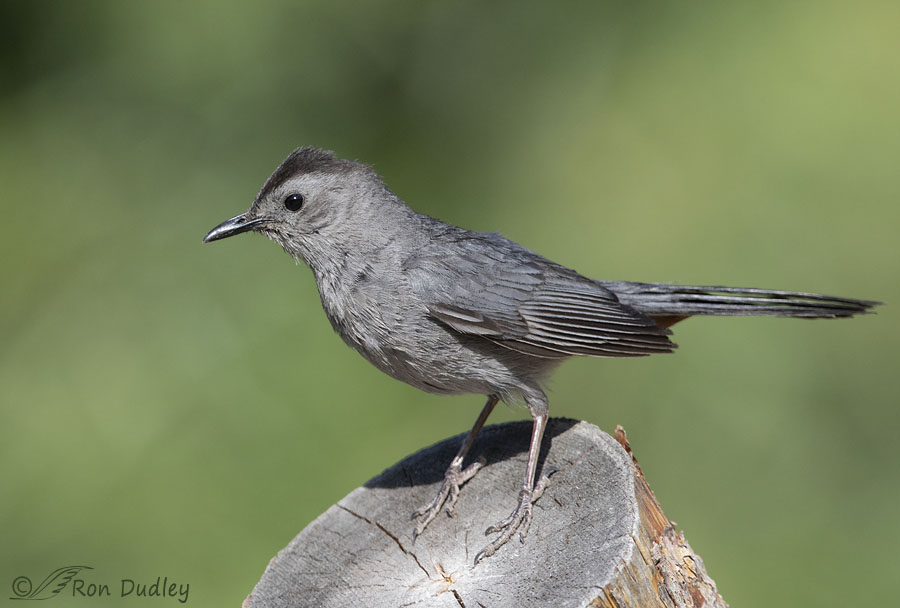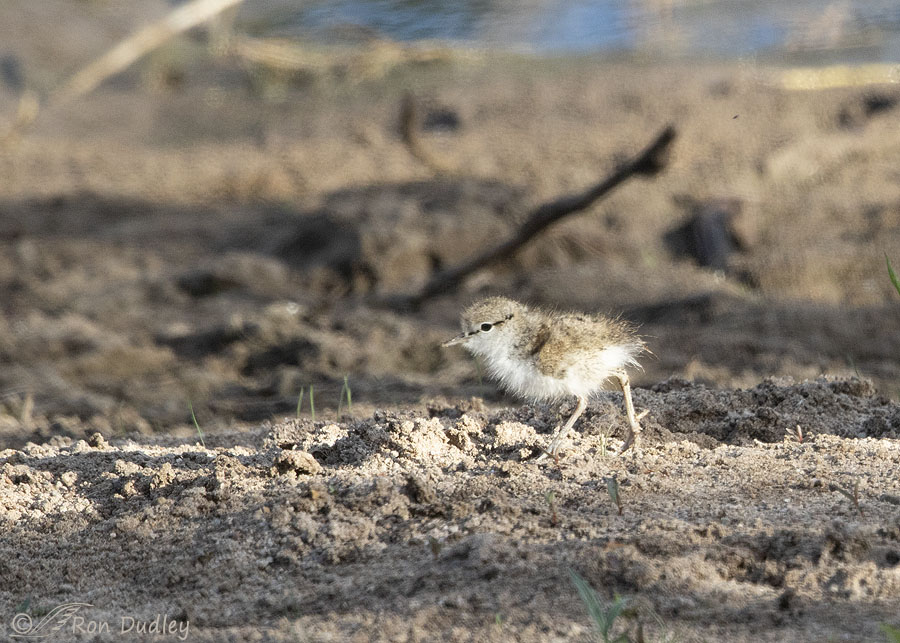And my first look ever at a recently hatched Spotted Sandpiper chick. This little guy is cute as snot (to paraphrase my ex wife).

1/1600, f/6.3, ISO 800, Canon 7D Mark II, Canon EF 500mm f/4L IS II USM + EF 1.4 III Extender, not baited, set up or called in
Because they’re so elusive and shy I very rarely get completely clear shots of catbirds. But yesterday morning in the mountains this one was interacting with a group of immature robins in a camping area so it was much bolder than usual and I was able to get off about a dozen quick shots while it was perched on this leaning fence post quite close to me.
Readers may remember our recent discussion about two of the primary types of bird photography – Bird On A Stick (BOAS) and Bird In Habitat (BIH). I guess this photo would fall in the BOABS category, as in Bird On a Big Stick…
I wish I had enough depth of field to get the tail sharper but I do like the clean look at an elusive catbird.

1/400, f/11, ISO 800, Canon 7D Mark II, Canon EF 500mm f/4L IS II USM + EF 1.4 III Extender, not baited, set up or called in
But the biggest surprise of the morning was to find several recently hatched Spotted Sandpiper chicks near a creek bottom. They were far away and I only got photos of this one but what a treat to watch it through my viewfinder. While I was following it with my lens I mostly waited to take photos of it hoping it would eventually walk into this narrow beam of light filtering through the nearby bushes. And finally it did.
- Note to photographers: Usually when I have inappropriate camera settings like this I call it a mistake. But this wasn’t a mistake, it was more like a mysterious accident. I know my aperture had been set at f/6.3 just prior to this bird and I never changed it so I assumed it was still f/6.3 when I took this shot (in the excitement of the moment I didn’t check my settings while I was photographing the chick). I didn’t notice it had changed until I had driven down the road. How it changed, I have absolutely no idea. I was lucky that any of my shots of this youngster were even close to sharp. Poop happens in bird photography.
Anyone familiar with Spotted Sandpipers knows of their penchant for “teetering,” an up and down bobbing of the entire body similar to the motion of a teeter-totter or seesaw. They teeter almost constantly whether they’re walking or standing still. I call it butt-bumping and it’s cute as hell to watch. Well this little guy was already teetering even at this tender age. In fact, teetering begins at 30 minutes after hatching, a full 90 minutes before they even begin to eat or preen.
The behavior is deeply engrained in their DNA but the function of teetering is unknown.
Ron
Note: If you’d like to see Spotted Sandpiper chicks and adults “teetering” here’s a link to a video clip. Thanks for the link Muffy S. Gately.


I like the reference to BOABS a nice shot of a Catbird and well, that is such a cute ball of fluff. They are so vulnerable, I stand in awe of how any of them manage to survive.
I went to YouTube for a video of the chicks. They are cute.
Cute as snot? That is a new one on me.
Was awed at both shots (as I so often am). Megathanks.
The little bit of the video upset my currently delicate tummy. That up and down motion was too much. I wonder how the birds cope…
EC, as I said my ex used to say that all the time. I guess it stuck with me (as snot tends to do). Good luck with your tummy!
Love both photos! I really like the way the darker gray forms that modified crest on the catbird. Mine is still sticking around…playing with me when i’m in the gardens, hiding in the gray dogwood shrubs and hazel shrubs. Love that bird. I like Judy’s description of the baby…’cottonball on twigs’. There is a killdeer that brings her two babes to my mother’s yard for seed several times a day…she calls them ‘golfballs on little stilts’. What joy nature gives us. Finally got power back yesterday afternoon…four days with out it and a pumping well is way too long! Makes one appreciate the simple life!
Gray Catbird in gray dogwood. I like that.
Congrats on your return to the world of electricity, Kathy. I’m sure it’s been a huge ordeal.
I’d love to see a Gray Catbird, which are rare here. Who knew shades of gray could be so beautiful.
The Spotted Sandpiper teetering is a hoot. It looks like they have overactive leaf springs in their undercarriage.
Ha, that’s a good description, Lyle.
Nothing is much cuter than a shorebird chick of any kind and Spotted Sandpipers are no exception. Teetering that rear end up and down is fun to watch, but I know of no one who can give you an explanation, not even those researchers who have made a detailed study of their lifestyle. It remains a mystery. American Dippers bob their whole body up and down, but in that case, one explanation is that it helps make them visible to other dippers against the fast moving water behind them, but that explanation doesn’t work for Spotted Sandpipers.
Then it will remain a mystery, at least for now. Thank you, Dan.
Nice Catbird photo and the sandpiper is a delight. The other day in Little Cottonwood Canyon I saw a American Dipper juvenile that still had a bit of down on it’s head doing its bobbing dance at the waters edge, it would put it’s head in the water but I did not see it jump in. It was back lit and too dark to get a photos but I enjoyed watching it and it’s parent feed it. Birds are fun to watch!
They sure are, April. I see dippers almost every time I go to Cascade Springs.
Thanks for including the link to the video clip showing the “teetering”—-really interesting behavior. Since the adult also does it, it’s not likely, as I first guessed, an exercise in establishing a sense of
balance over those very long legs. I hope that someone in your posse might have an insight !
I hope so too, Kris. I imagine there have been plenty of educated (and not so educated) guesses about the function but Cornell says it is unknown.
It’s pretty frustrating when someone changes your settings and don’t tell you about it. Teetering? Parrelax (sp?)?
Hmmm, I’ll have to speak to Mia about that possibility… 🙂
I’ve never seen a Spotted Sandpiper chick and never heard of teetering unless it was back in my Navy days after a little too much to drink. Educational post Ron thanks.
Everett, from what I’ve heard about Navy guys it was often more than just “teetering”… 🙂
Nice! Wonderful to get the gray catbird out in the open! 🙂 They are pretty birds – love that particular shade of gray. 🙂 Cute little snot indeed! 🙂 Wonder if the teetering makes them blend in somehow? I would think it would call attention to them… always a puzzle. Brand new Killdeer – cotton balls on toothpicks – are the ones that get me grinning ear to ear. Cliff swallows left BUT have swallows again – took awhile but believe they are violet-green swallows! Boy are THEY fast! Some years we have a “gathering of swallows” across the creek – much larger numbers than this – for fall departure. Now believe they are probably these – just never paid attention other than there were a LOT of swallows about 😉 You have me paying more attention! 🙂 Thx!
101 here yesterday…… 🙁
Judy, I only remember seeing Violet-green Swallows once, about 40 years ago near the “hotpots” just out of Heber City.
I’ve been trying to figure out a possible function for teetering but can’t think of one. It must have some advantage though, otherwise the behavior wouldn’t have been selected for. After all, if it had no advantage it would be energy wasted and selected against.
Edit: A few minutes after you posted your comment I added a link to a video clip of chicks and adults teetering. You might want to check it out.
I just did – VERY interesting! 🙂 Does seem, at times, it matches the movement on the water in this case……. 🙂
Actually, I think they are a bank swallow as, from my lousy low light photos, it appears they do have a “collar” and “song” sounds correct – also quite small. 1st “noises” I listened to certainly weren’t them……….:) Your comment on how seldom you’d seen the violet-green got me trying to look closer……. 🙂
I saw Violet-green swallows in Heber the other day along the Provo River fishing areas by River Road. Also they are abundant at Calf Creek area in southern Utah. I tried to get photos in Heber but they were out of my focal range and in the shade most of the time.
April, I’ve hiked into the upper Calf Creek falls many times but that was years ago so I may have seen them but didn’t pay much attention.
That little chick is truly adorable. The catbird is a handsome fella! Good morning!
Thanks, Arwen. Good morning to you also.